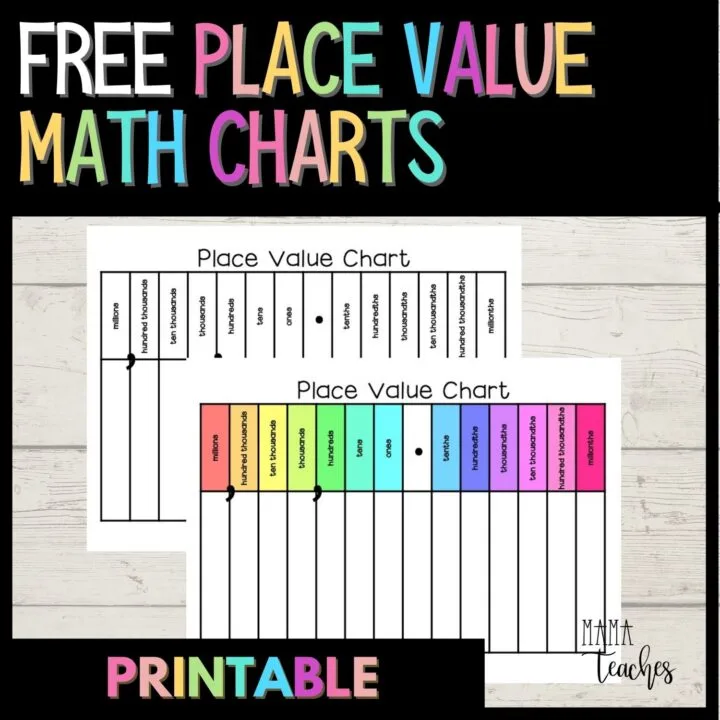Your kids are ready to move beyond whole numbers and into decimals, but how do you make it fun?
Close the workbooks and learn how to teach decimals in an engaging, hands-on approach.

This article contains affiliate links to things that you might like.
What Are Decimals?
Decimals are, essentially, fractions whose denominators are multiples of 10.
A fraction can have any denominator: ⅙, ⅔, ¾, and so on, but decimals can only be divided by numbers like 10, 100, 1000, and the like.
When you see the decimal 0.2, you would say it is “two tenths.” Its fractional equivalent is 2/10.
When you see the fraction 0.25, you would call that “twenty-five hundredths” because it is equal to 25/100.
Decimals were invented by the Chinese in the 4th century, and from there spread to the Middle East and Europe.
Today these decimals have their own special notation; they follow a decimal point.
Why Are Decimals an Important Skill to Master?
Very few numbers in real life are whole numbers (1, 2, 3, 4, etc.).
Rarely do walk a trail exactly 1 mile long, or catch a 2 lb. fish, or have a restaurant bill come to exactly $30.
We need ways to express parts of a whole, and decimals are the most common way to do that.
Decimals are pivotal to understanding our system of money (cents are all decimals), making measurements, and solving equations in advanced math.
They allow us to be precise, and precision matters in fields like science, cooking, art, business, and computers.
Decimals are a transition to abstract math, so they can be tricky for kids to master.
While a child can visualize (and count) 0.1 with the right manipulatives, decimals such as 0.637 are harder to envision.

Fun Ways to Teach Decimals
Though decimals can be intimidating to some students, the right teaching approach can not only make them click sooner, it can make them fun!
Money
Dollars are based on whole numbers, but cents are decimals.
After the decimal point, dimes occupy the tenths place and pennies occupy the hundredths place.
Teach decimals using real (or imitation) money.
Count out coins and turn their value into decimals.
Classroom Economy
Plenty of classrooms use a point-based reward system, but why not use dollars and cents instead (even if they are only imaginary)?
You can also teach financial principles like saving and budgeting with the free program My Classroom Economy.
It overlays your curriculum (or an individual subject) to teach grade-specific concepts from Kindergarten to high school.
Bonus: You can use it as a classroom management tool.
Real-Life Shopping
Why not get math out of the workbook and into the real world?
Use real-life shopping circulars to add and subtract.
Set budgets, pick your favorite items, and then count your change.
If your school has a book fair or a fundraising drive, don’t let the pitch go by without tying it to decimals.
Fill out sample order forms, and do the math together.
You Might Also Like: Rainbow Restaurant Math

Real-Life Measurements
Measuring requires precision, and that means decimals!
Measure the world (including students’ heights) with the metric system, which is already a base-10 system.
A child can know they are 4 feet tall, but does he know he is actually 1.23 meters?
You can also use a digital kitchen scale to turn baking into an exercise with decimals.
Professional bakers don’t use measuring cups; they use scales!
You can find plenty of baking by weight recipes on Joy of Baking and King Arthur Flour.
Simply change the weight amounts from grams to kilograms and–presto!
You’ve got decimals.
Place Value Charts
Decimals are a transition to abstract math, but you can still initially tie the concept to math you can touch and see.
Decimal place value can easily be visualized with a place value chart.
(You can find one for FREE in the Freebies Library!).
A decimal place value chart has a spot not just for whole numbers (like the ones, tens, and hundreds places), but it also includes the tenths place and the hundredths place.
Use manipulatives such as small discs, beans, or Cheerios to occupy the spaces.
Decimal Tiles
These fraction and decimal tiles will help your students memorize common decimals.
The colorful, stackable tiles reinforce both fraction and decimal lessons (and show how they are really two sides of the same coin).
Digital Escape Rooms
Why not practice decimals with a digital escape room?
We have three FREE decimal digital escape rooms to choose from.
This first digital escape room focuses on decimal place value, from the tenths place up to the millionths places.
This second digital escape room reinforces adding and subtracting decimals.
The third escape room requires the student to multiply decimals.
Apps
Game-based learning is a wonderful way to reinforce the concept of decimals.
Try apps such as SplashLearn, Prodigy, and Buzzmath.

Teaching Decimals To Kids
Decimals don’t have to be dull.
Spice them up with these hands-on activities and learn how to teach decimals the fun way!
Who knows?
Your kids may soon be begging for more math!

